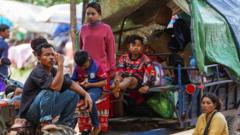In a small village near Bucharest, Romania is witnessing a cultural clash sparked by the beloved traditional blouse, known locally as “ie.” This embroidered attire, prominently worn by women in rural communities, has gained unexpected popularity among nationalist politicians, transforming it into a symbol of national pride. Figures such as Diana Sosoaca, a far-right politician, and George Simion, a recently unsuccessful presidential candidate, have adopted the blouse as part of their political identity, often showcasing it in public appearances.
Diana Sosoaca has made the "ie" a staple of her wardrobe, reinforcing her nationalist ideals through this culturally significant garment. Similarly, George Simion's supporters resonate with the blouse's attainability and the nationalist sentiment it evokes. The ultranationalist Calin Georgescu also embraced the blouse, leveraging it in campaign videos on social media platforms like TikTok.
The renewed interest in the Romanian blouse isn't without contention. Whereas nationalists see it as a representation of societal traditions, many liberals argue its emergence in political narratives risks appropriating a collective cultural identity, diluting its significance. This ongoing debate accentuates the garment's historical value as more than a mere piece of clothing but rather an embodiment of community heritage and cultural expression.
Artisans and local craftsmen, such as those working at the National Village Museum in Bucharest, continue to emphasize the intricate craftsmanship behind these designs, often taking months to perfect a single blouse. As political leaders embrace this symbol, the broader conversation surrounding cultural identity, nationalism, and appropriation continues to evolve in Romania, underscoring the complex interplay between clothing, culture, and politics.


















